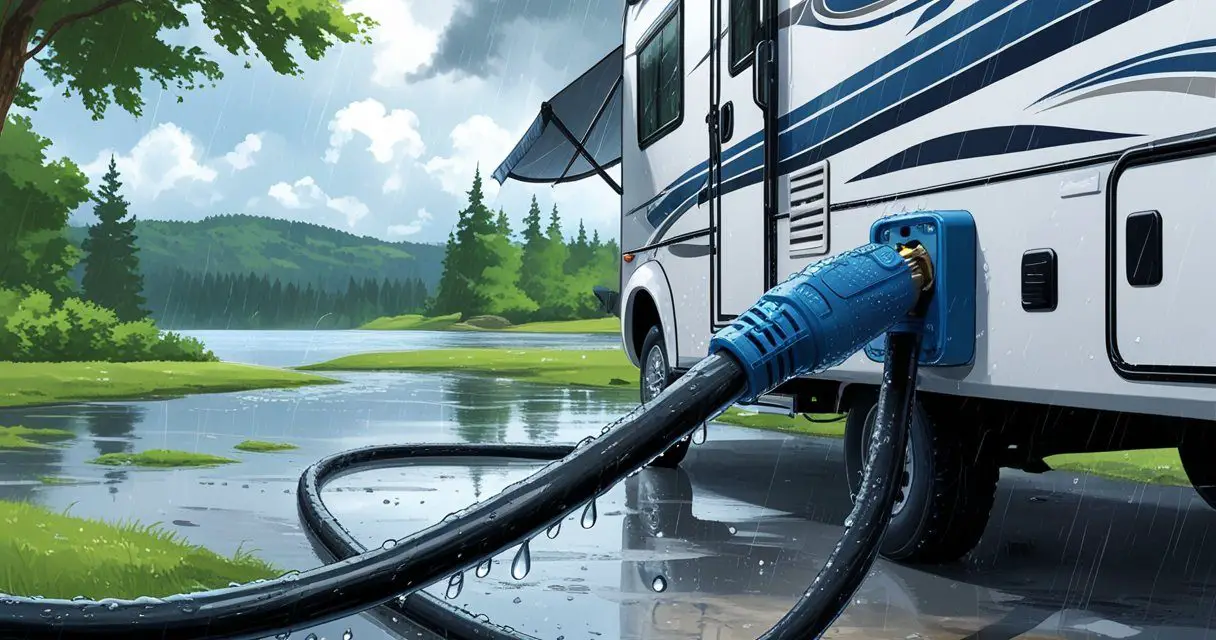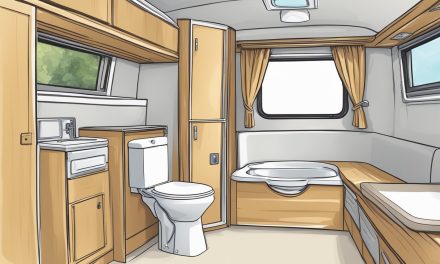Would you like to save this article?
When you’re setting up your RV at a campsite, it’s easy to overlook how weather can affect your power setup. Rain, dew, or standing water might seem harmless, but they can quickly turn into a safety issue when electricity is involved.
RV extension cords should never get wet because water can cause short circuits, corrosion, or even electric shock.
You might think outdoor-rated cords are built to handle a little moisture, and while some are more resistant, they’re not waterproof. Even small cracks or loose connections can let water in, creating hidden hazards that can damage your RV’s electrical system.
Knowing how to protect your cords and what to do if they get wet keeps your setup safe and reliable.
Key Takeaways
- RV extension cords should stay dry to avoid electrical hazards.
- Moisture can damage cords and increase the risk of shock or fire.
- Proper setup and maintenance help prevent water-related issues.
Can RV Extension Cords Get Wet?
RV extension cords can handle limited exposure to moisture if they are rated for outdoor use and kept in good condition. Water can still cause damage or safety hazards when it reaches the plug ends or damaged insulation, so you need to understand how moisture affects cords and how to prevent it.
How Water Affects Extension Cords
Water and electricity are a dangerous mix. When a wet extension cord allows moisture to reach the internal wires, it can cause short circuits or electrical leakage.
This can trip breakers, damage your RV’s electrical system, or create a shock hazard. If you use a cord that is not designed for wet conditions, water can quickly enter through cracks, cuts, or loose plugs.
Even small amounts of moisture can corrode metal contacts and weaken insulation. Over time, this reduces the cord’s ability to carry current safely.
You should always unplug a wet cord before touching it. Allow it to dry fully before reuse, and inspect for soft spots or exposed wires.
If any damage is visible, replace the cord instead of trying to repair it.
Differences Between Indoor and Outdoor Extension Cords
Not all extension cords are built the same. Indoor cords are lighter, have thinner insulation, and are not safe in damp or outdoor areas.
Outdoor extension cords are thicker, have weather-resistant jackets, and often include a “W” rating printed on the cord to show they meet outdoor safety standards.
| Type | Use | Weather Resistance |
|---|---|---|
| Indoor | Inside only | None |
| Indoor/Outdoor | Light outdoor use | Limited |
| Outdoor | Full outdoor use | High |
For RVs, you should only use heavy-duty outdoor cords rated for the amperage your RV requires. Look for cords labeled SJTW or STW, which resist moisture, abrasion, and sunlight.
Using the wrong type can lead to overheating or power loss, especially in wet conditions.
Common Scenarios Where RV Cords Get Wet
Your RV extension cord can get wet in several everyday situations. Rain, dew, or snow can collect around the plug connection when parked at a campsite.
Puddles or wet grass can also expose cords lying on the ground to moisture. If you run power from an outdoor outlet, water can drip from the roof or awning onto the connection point.
Even washing your RV can splash water onto the plug ends. To reduce risk, keep connectors off the ground using a cord reel or support.
You can also use weatherproof covers or sealing boots to protect plug connections. Always plug into a GFCI outlet when operating in damp areas.
These steps help prevent electrical shock and extend the life of your RV’s power cord.
Risks and Dangers of Wet RV Extension Cords
When an RV extension cord gets wet, it can create serious electrical hazards that may harm people and equipment. Water can cause electric shock, short circuits, and corrosion that weakens the cord over time and increases the chance of fire or equipment failure.
Electrical Hazards and Shock
Water conducts electricity, so when moisture enters an extension cord, it can create a path for current to travel where it shouldn’t. This increases the risk of electric shock or even electrocution if you touch the cord or plug while it’s energized.
Even a small amount of moisture inside connectors can cause current leakage. That leakage may not trip a breaker but can still deliver a painful or dangerous shock.
Using a Ground Fault Circuit Interrupter (GFCI) outlet helps protect you by cutting power when it detects current flowing through an unintended path, such as water or a person. Always unplug a wet cord immediately and let it dry completely before reuse.
Short Circuits and Fire Hazards
Water inside a cord can cause a short circuit, where electricity flows directly between wires instead of through the intended circuit. This can generate heat, damage insulation, and lead to melted connectors or sparks.
A short circuit can also overload your RV’s electrical system or trip breakers. In severe cases, it may ignite nearby materials and start a fire hazard.
To reduce these risks, use outdoor-rated cords with heavy insulation and keep all plug connections raised off the ground. Avoid running cords through puddles or wet grass, and check for cracks in the outer jacket before every use.
Corrosion and Long-Term Damage
Even after a cord dries, moisture exposure can cause corrosion inside the plug blades and sockets. Corrosion increases electrical resistance, which makes the cord heat up during normal use and shortens its life span.
Rust or green discoloration on metal contacts is a clear sign of damage. Over time, this can lead to poor connections, intermittent power loss, and greater risk of electrical hazards.
To prevent corrosion, store cords indoors in a dry place and keep connectors covered when not in use. Regular inspection helps ensure safe and reliable operation of your RV’s electrical system.
Immediate Actions if Your RV Extension Cord Gets Wet
If your RV extension cord becomes wet, act quickly to prevent electrical shock or equipment damage. Focus on cutting off power safely, checking for visible or hidden damage, and ensuring the cord is completely dry before reuse.
Safe Disconnection Procedures
Never touch a wet cord while it’s still connected to a power source. Go to your RV’s breaker panel and switch off the circuit that powers the outlet.
If the cord is plugged into a campground power outlet, turn off the pedestal breaker before handling it. Use dry, insulated gloves or a tool with a nonconductive handle to unplug the cord.
Avoid standing in water or on damp ground during this step. Once disconnected, move the cord to a dry, shaded area.
Label or mark it as “wet” to remind yourself not to reconnect it until it’s inspected and dried. Always treat a wet extension cord as unsafe until proven otherwise.
Inspection for Damage
After disconnecting, check the cord for visible signs of trouble. Look for cracks, cuts, bubbling, swelling, or discoloration along the insulation.
These may mean water has entered the internal wiring. Pay close attention to both plug ends.
If you see corrosion, rust, or moisture inside the prongs or sockets, the cord may no longer be safe to use. If the cord feels stiff or gritty when bent, internal moisture or corrosion may be present.
In that case, replacement is safer than repair. Use a multimeter to test continuity and insulation resistance if you have one, or ask a qualified technician to do so before reuse.
Proper Drying Methods
Dry the cord slowly and completely before testing it again. Hang it vertically in a warm, low-humidity area so water can drain from the ends.
Do not use heat guns, ovens, or direct sunlight, as these can damage insulation. Let the cord dry for at least 48 to 72 hours.
You can speed drying with gentle airflow from a fan or dehumidifier. Once dry, plug the cord into a GFCI-protected outlet first.
If the outlet trips or the cord feels warm during use, stop immediately and replace it. Proper drying and testing ensure safe operation and prevent electrical hazards.
Preventing Water Damage to RV Extension Cords
Moisture can corrode metal contacts, weaken insulation, and increase the risk of electrical shock. You can reduce these risks by choosing proper outdoor-rated cords, using safety devices that detect faults, and keeping all connections protected from rain and puddles.
Choosing the Right Outdoor Extension Cord
Use outdoor-rated extension cords marked with a “W” on the jacket. These cords have thicker insulation and are designed to handle exposure to moisture, sunlight, and temperature changes.
Select a cord that matches your RV’s amperage and voltage requirements. A cord that is too light can overheat or lose power efficiency.
For most RVs, cords rated for 30 or 50 amps are common. When possible, choose cords with molded plugs and weather-resistant jackets made from heavy-duty rubber or vinyl.
These materials resist cracking and water intrusion better than standard indoor cords. Inspect cords before each use for cuts, frays, or rust on the prongs.
Replace any damaged cords immediately rather than attempting repairs, since damaged insulation can allow water to reach the wires.
| Cord Type | Marking | Best Use |
|---|---|---|
| Outdoor-rated | W | Wet or damp areas |
| Heavy-duty RV cord | TT-30 or 14-50 | RV hookups |
| Indoor cord | None | Dry, indoor use only |
Using GFCI Outlets and Safety Devices
A Ground Fault Circuit Interrupter (GFCI) outlet helps protect you from electric shock if water causes a short circuit. It quickly shuts off power when it detects current flowing through an unintended path, such as water or a person.
Install GFCI outlets in any outdoor power source you use for your RV. If the outlet isn’t GFCI-protected, use a portable GFCI adapter between the outlet and your extension cord.
Test each GFCI device monthly using the built-in test and reset buttons. A properly functioning GFCI can prevent serious injury and reduce equipment damage from moisture exposure.
Avoid plugging multiple cords or devices into a single outlet, as this can overload the circuit and interfere with the GFCI’s ability to trip correctly.
Protective Covers and Cord Management
Keep all cord connections elevated and off the ground. Use hooks, stands, or brackets to route cords above puddles or wet surfaces.
This prevents water from pooling around plugs and reduces tripping hazards. Use weatherproof connector covers or cord protection boxes to seal the area where two cords join.
These covers block rain and splashes while maintaining airflow to prevent condensation. If you need a quick temporary fix, wrap the connection in a plastic bag secured with rubber bands, but replace it with a proper waterproof housing as soon as possible.
Store cords in a dry, shaded area when not in use. Coil them loosely to avoid kinks and ensure they dry completely before storage.
Proper management and storage extend the life of your cords and help maintain safe electrical connections.
Safe Usage and Best Practices in Wet Conditions
Keep your extension cord dry whenever possible, but when outdoor use is unavoidable, focus on protection, inspection, and proper care. Moisture can damage insulation, corrode metal parts, and increase the risk of electric shock or fire if not managed carefully.
Proper Storage and Handling
Store your extension cord in a cool, dry location away from direct sunlight and standing water. Moisture trapped in coils can lead to corrosion, so hang cords vertically or loosely coil them to allow air circulation.
When using cords outdoors, elevate connections off the ground with cord covers or hooks. Avoid running cords through puddles, grass, or soil where water collects.
Use outdoor-rated cords marked with a W or SJTW rating. Connect them to GFCI-protected outlets that shut off power if they detect current leakage, reducing shock risk.
Keep plug connections snug and protected with weatherproof covers or plastic housing boxes. Never tape or wrap cords to seal them; trapped moisture can worsen damage.
Regular Inspection and Maintenance
Inspect cords before and after each use. Look for cracks, swelling, or discoloration that may indicate water damage or insulation failure.
Replace cords with visible wear or exposed wiring. Use a flashlight to check for small abrasions that could allow moisture inside.
After wet use, dry cords fully before storing—hang them for at least 48 hours in a low-humidity area.
Create a simple inspection schedule:
| Frequency | Action | Purpose |
|---|---|---|
| Monthly | Check plugs and jackets | Detect early damage |
| Quarterly | Test with GFCI outlet | Confirm safe operation |
| Yearly | Apply silicone protectant | Extend insulation life |
When to Replace or Discard a Wet Extension Cord
You should replace a wet RV extension cord if it shows signs of damage that affect electrical safety or performance. In some cases, professional testing or disposal is the safest way to prevent shock, fire, or equipment failure.
Signs of Irreversible Damage
Inspect the cord carefully after it dries. Look for cracked insulation, corrosion on plug blades, or discoloration near connectors.
These are signs that moisture has entered the wiring and weakened the insulation. If the cord feels stiff, brittle, or has a burnt smell, it should not be used again.
Use this quick guide to help decide:
| Condition | Safe to Reuse? | Action |
|---|---|---|
| No visible damage, GFCI test passes | Yes | Dry completely and test before use |
| Frayed or melted insulation | No | Replace immediately |
| Rusted or green-colored contacts | No | Discard safely |
Never try to repair a cord with electrical tape if the copper conductors are exposed. Once water has reached the internal wiring, the risk of short circuits and electric shock increases even after drying.
Professional Assessment and Disposal
If you are unsure about the cord’s safety, have a qualified electrician test it with a continuity or insulation resistance meter. Professionals can confirm whether the cord meets electrical safety standards before reuse.
Do not attempt to open or rewire the plug yourself.
For cords that fail inspection, dispose of them properly. Cut off both ends to prevent reuse.
Coil the remaining cable, and drop it off at an electronic waste facility or recycling center. Avoid throwing damaged cords in regular trash where they can pose fire or injury risks.





